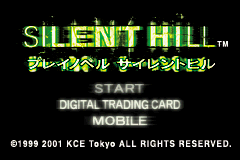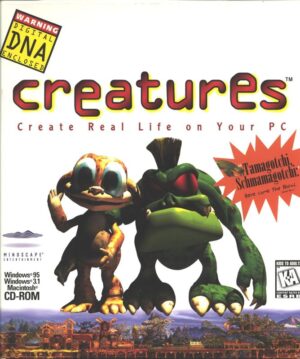Retro Replay Review
Gameplay
Silent Hill: Play Novel takes the familiar horror foundations of the first Silent Hill and transforms them into an interactive, text‐driven adventure. Rather than wandering through 3D environments, you guide officer Cybill Bennett through a series of illustrated narrative segments. At each step, you’re presented with two or three choices, each potentially leading to vastly different outcomes. This choose‐your‐path structure creates a strong focus on decision‐making and encourages multiple playthroughs.
(HEY YOU!! We hope you enjoy! We try not to run ads. So basically, this is a very expensive hobby running this site. Please consider joining us for updates, forums, and more. Network w/ us to make some cash or friends while retro gaming, and you can win some free retro games for posting. Okay, carry on 👍)
While there are no action sequences or puzzles in the traditional sense, the game effectively builds tension through well‐written descriptions and sudden shifts in atmosphere. Because the story branches frequently, your choices feel weighty: one seemingly innocuous decision can lead to a safe resolution or a grisly fate. Fans of “Play Novel” or visual novel mechanics will appreciate how each line of text and each illustration work together to ratchet up the suspense.
However, potential buyers should note that outside of the menu screens, everything is presented in Japanese. This makes it essential for non‐Japanese speakers to rely on fan translations or guides if you want to understand every nuance of the story. Even so, the gameplay loop remains engaging: read, decide, and discover the repercussions of each choice until you’ve uncovered all possible endings.
Graphics
Graphically, Silent Hill: Play Novel is rooted in its era but uses its limited resources to great effect. Instead of full‐motion cut‐scenes, the game deploys carefully composed static illustrations that punctuate key moments. These images range from subdued, fog‐shrouded street views to close‐ups of battered interiors, providing the iconic Silent Hill aesthetic through still art.
The black‐and‐white or lightly tinted visuals keep you focused on the text while imparting a sense of dread. Character portraits are expressive, conveying fear, confusion, or resolve with minimal lines. Background art often uses shadows and negative space strategically, evoking the uncanny atmosphere the series is known for without relying on polygonal models or pre‐rendered video.
Because the game was only released in Japan, the menus and UI remain in their original form, but they’re simple and intuitive. Button prompts and selection cursors are clearly marked, so navigating through the passages and making choices feels seamless. Overall, the graphic presentation may not dazzle like modern horror titles, but its minimalist approach enhances the eerie tone.
Story
Silent Hill: Play Novel runs parallel to the events of the original PlayStation release, but through the eyes of officer Cybill Bennett. As a member of the America Police Department, Bennett arrives in the fog‐bound town to investigate a reported disappearance. Although you may recognize certain landmarks and references from Harry Mason’s journey, Cybill’s path introduces fresh twists and an entirely new perspective.
The narrative unfolds through short, atmospheric passages that emphasize suspense and psychological horror. You’ll experience unsettling encounters, cryptic messages, and the gradual unraveling of Cybill’s own fears. Since the game offers multiple branching routes, the story can shift dramatically: one path might reveal a tender moment of humanity, while another plunges you into grotesque imagery.
For fans of Silent Hill lore, this side story fills in gaps and deepens the series’ mythology. It explores themes of duty, trauma, and the inescapable pull of the town’s darkness. Even if you’ve completed Harry’s tale, Cybill’s investigation provides surprising revelations and fresh emotional beats that stand on their own merits.
Overall Experience
Silent Hill: Play Novel caters to a niche audience—those who appreciate narrative‐focused horror and don’t mind overcoming the language barrier. The absence of real‐time action puts the spotlight squarely on atmosphere and storytelling, making every choice feel meaningful. Multiple endings and hidden paths deliver strong replay value for completionists.
Importing the game requires either proficiency in Japanese or access to translation resources. Thankfully, the simple menu layout and intuitive choice system minimize guesswork when navigating the text. If you’re a dedicated Silent Hill fan or a visual novel enthusiast, the effort to engage with the untranslated script can be highly rewarding.
Ultimately, Play Novel: Silent Hill offers a unique twist on the franchise’s formula. It transforms the classic foggy streets into a branching literary journey, driven by your decisions. Though it may lack the polished graphics and direct interactivity of its console counterparts, it excels at weaving a haunting story that lingers long after you’ve closed the book.
For collectors and series devotees, this Japanese‐only adventure is a standout curiosity that expands the Silent Hill universe. Its minimalist presentation, compelling narrative, and deeply atmospheric illustrations make it a memorable detour from conventional horror gameplay—just be prepared to embrace the challenge of an untouched Japanese script.
 Retro Replay Retro Replay gaming reviews, news, emulation, geek stuff and more!
Retro Replay Retro Replay gaming reviews, news, emulation, geek stuff and more!









Reviews
There are no reviews yet.